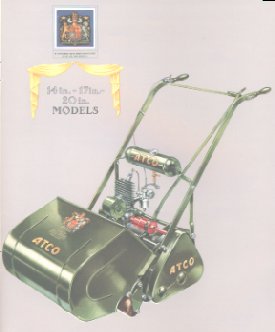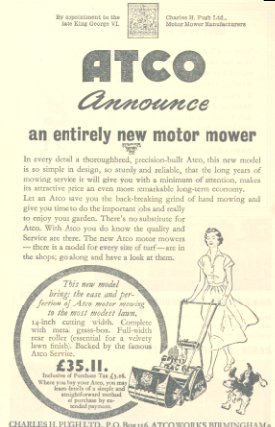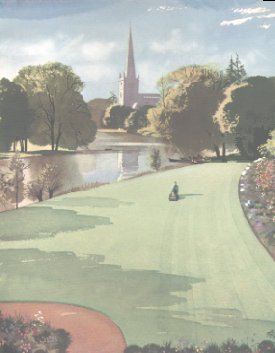MP030: Atco Light Two Stroke Motor Mower, 1950s

By the 1950s Atco had become probably the best known name in British motor mowers. The company began manufacturing motor mowers in the 1920s but the machines produced in the 1950s were very different.
The original Atco Motor Mowers were made from cast iron open frames and were powered by large two or four stroke petrol engines. The Light Atco motor mowers produced in the 1950s utilised a plate steel chassis and were powered by more compact 97cc Villiers two stroke engines.
The cost of mowers had also reduced thanks to the success of mass production in the mower industry that was pioneered in the UK with the first Atco Motor Mowers. This meant that an Atco mower of any given size cost less in the 1950s (in real and absolute terms) than its 1920s counterpart, in some case only half as much.

Despite the advances there were some similarities between the 1920s and 1950s Atco mowers. The design is unmistakably Atco, especially the cylindrical petrol tank with its rounded ends used on all Atco models from the 1920s to the end of the 1950s. Although the engines were more compact, they were still essentially the same Villiers design introduced just after the First World War with the familiar flywheel magneto. The mowers also had the long clutch lever even though companies such as Qualcast and Ransomes had already introduced cable operated designs for their machines.
As with its predecessors, the 1950s Light Atco motor mower was designed for simple, low cost manufacture and maintenance. The mower was available in 14", 17" and 20" cutting widths. Larger 28" and 34" cutting width models were powered by a Villiers four stoke motor and were also known as Light Atco motor mowers. The description of the mower as being "light" may seem slightly misleading for such large machines but it was at the time intended to differentiate the mowers from other Atco mowers designed for specialist or professional use that featured heavier and/or stronger components.
In its 1953 motor mower brochure, Atco explained some of the advantages of its mowers:
-
The use of a smaller capacity power units, resulting in an appreciable saving in the consumption of petrol and oil, and this must particularly appeal in these days of ever increasing costs of fuel.
-
Ease of control and handling, especially of the larger models, with consequent lessening of fatigue to the operator over long periods of mowing.
-
Ease of movement from place to place, especially where it is necessary to load the machine into a vehicle.
-
Reduction f the initial purchase price and maintenance and upkeep charges.
-
Avoidance of over compaction of the soil to the detriment of the turf of fine playing surfaces such as golf greens, bowling greens, cricket squares etc.
There was a high degree of component sharing between models in the Light Atco motor mower range to allow engineers to replace broken or worn parts quickly and easily. The mowers featured an innovative kick start device that eliminated the need for cumbersome (dare we say dangerous) handle start of the pre-war machines. Although some Atco mowers from the 1930s did have a kick start mechanism it was neither popular or successful. The 1950s design was much better and for this reason the Atco mowers from this period are often referred to by collectors and enthusiasts as the "kick start Atcos". Rope start (first with loose rope and later with integrated recoil) was introduced in the middle of the decade.
It is often difficult to date Atco mowers with any degree of certainty. Indeed, the standardisation of design that was such an Atco trademark made knowing the exact date of manufacture largely unnecessary from a servicing and support point of view. However, during the 1950s models make dating the machines a bit easier by fitting a small brass plate on the side of each mower. This plate contained a number of the format AABB/C. The AA was the size of cutting width in inches. The BB designated the year in the 1950s that the mower was made. The C was an optional number used to differentiate between different models in the range with the same cutting width. So, for example, a machine with the number 1455 was a 14" model made in 1955. Because all Atco mowers were the same, the customer simply had to tell the service engineer this basic code for the correct spare part for that size and model to be identified.
An interesting historical detail can be found in the Atco brochure from 1953. The company had received a Royal "By Appointment" Warrant from King George VI, who died in 1952. These warrants were awarded for a fixed period and, until that time had ended, companies were allowed to continue using them. The 1953 brochure therefore refers to its warrant with the wording "By Appointment To The Late King George VI, Charles H Pugh, Motor Mower Manufacturers". When the Royal Warrant was renewed it was of course awarded by the present Queen, HM Queen Elizabeth II.

The 1950s Light Atco motor mower can be seen as the last of the company's classic mower designs. Although the machine was powered by the usual Villiers two stroke unit, these were smaller and lighter than units with the same power fitted on earlier machines. The next Atco mowers introduced from 1958 onwards had even smaller two and four stroke units and later still the company broke its long time association with Villiers altogether.
The 1950s Light Atco Motor Mowers are not particularly rare but they do perhaps represent the link between the first motor mowers and the modern designs. A number are still in regular use and many enthusiasts have them in their collections.
